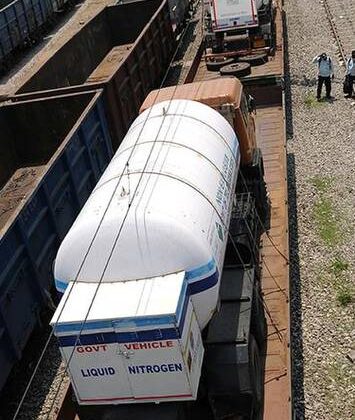
How to tackle the oxygen logistics nightmare
MUMBAI : Most liquid medical oxygen production facilities are located in suburban areas far away from the urban demand centres with most Covid-19 patients.
Learning to fight the novel coronavirus remains a mystery. While the infection rate has been increasing exponentially, hospitals in many urban locations are struggling to treat Covid-19 patients because of an acute shortage of oxygen.
The Centre has been trying several measures to address the oxygen shortage. Several new Liquid Medical Oxygen (LMO) production plants have commenced, and industrial oxygen is being routed for medical use. While the timely LMO production has provided some, albeit limited, relief to meet the demand, transporting the produced oxygen to demand locations remains a logistical challenge.
According to a recent government press release, as of April 21, the Centre has allocated 6,822 tonne per day against the demand of 6,785 tonne per day of LMO from 20 States. However, with the growing Covid-19 cases, the need for transporting LMO has increased dramatically, almost leading to an oxygen-logistics crisis.
Inherently, transportation demand is an outcome of the spatial separation of production facilities and consumption/demand centres. In this case, specialised cryogenic oxygen tankers fulfil this transportation demand. A quick assessment of the LMO production facilities reveals that many of these are located in suburban areas far away from the urban demand centres with most Covid-19 patients.
For example, the Ayanambakkam and Gummidipoondi centres of Tamil Nadu, Alambagh, and Modinagar facilities in Uttar Pradesh, and Pimpri-Chindwad of Maharashtra are all at a distance from the densely populated locations, where the infection rates are the highest. Other LMO production centres in Bhilai, Durgapur, and Rourkela are positioned far away from the prime city locations.
The Centre and State governments seem to have exhausted all their logistical options to increase vehicle supply for LMO transportation in the short run. Transport of LMO by rail, the green corridor, airlifting empty oxygen tankers, engaging the Indian Air Force, and free inter-State road movement are a few of the available options.
Unlike traditional commercial markets for conventional goods, the mismatch between oxygen supply and demand because of limited specialised transport capacity cannot be overcome by market-determined prices or rationing.
However, one solution to overcome the transportation supply constraint, at least in the short run, is to reduce the demand for transportation of LMO, a hazardous material. And, one possible way is to relocate some of the “demand” closer to the supply locations.
Moving patients
Here is one such possibility, at least in the short run: Transporting, including airlifting, non-critical Covid-19 patients from the high infection locations to places closer to LMO production facilities. Moving a few hundreds of non-intensive-care patients to the supply locations may provide a solution.
First, even a hundred non-ICU-bed reductions in cities will reduce the demand for transporting 1.4 million litres of oxygen per day. A back-of-the-envelope computation reveals that a non-intensive care Covid-19 patient, on average, requires approximately 10 litres ten liters per minute of oxygen.
Second, this may further reduce oxygen truckloads leading to more vehicle supply for other locations. For example, 3,000 oxygenated beds at an oxygen plant location will save four LMO truckloads per day (approximately 80 per cent of the total demand of a city like Lucknow). With a truck turnaround of roughly 2.5 days, this could potentially reduce 10 trucks needed to serve the location.
This can also help buy time, without losing precious lives, to build in-situ oxygen plants at hospitals or other centres.
While discussing the idea with a bureaucrat, the official mentioned, “all additional non-ICU beds catering to Covid-19 patients should come near industrial-use oxygen plants (like steel plants, fertilizer or refineries) rather than in the cities. For example, additional beds should come up at IFFCO-Kalol instead of Gandhinagar, IOC Panipat instead of Delhi/NCR, IFFCO-Paradip instead of Bhubaneswar.”
The recent announcement of Arcelor Mittal-Nippon Steel to build a 1,000-bed facility at Hazira instead of enhancing beds at Surat, which is just 23 km away, is a step in the right direction. While the idea of moving demand closer to supply locations seems implementable, it needs an ecosystem to turn it into reality. Airlifting Covid-19 patients, though challenging, is not impossible. All aircraft have oxygen cylinders to last 15-20 minutes — by reducing the aircraft load to one-fourth of its capacity — flight times of 60-80 minutes are achievable.
Other factors include the availability of doctors, attendants, medications, and other services closer to the supply locations. One way to facilitate these resources is to prefer supply locations closer to existing airports or transportation centres — allowing mobilisation of doctors, paramedics, medicines, and reverse logistics (recovered patients, additional intensive care, or air ambulance requirements) at short notice.
Given the rate at which Covid-19 infection is rising, the demand for oxygen may not reduce in the short run. But the demand for LMO transportation can be reduced till adequate oxygen supply is made available. Thus, moving the non-critical demand closer to the supply facilities could help partially address the oxygen logistics problem.
The writers are Faculty Members, Indian School of Business, Hyderabad
Source : The Hindu Business Line
